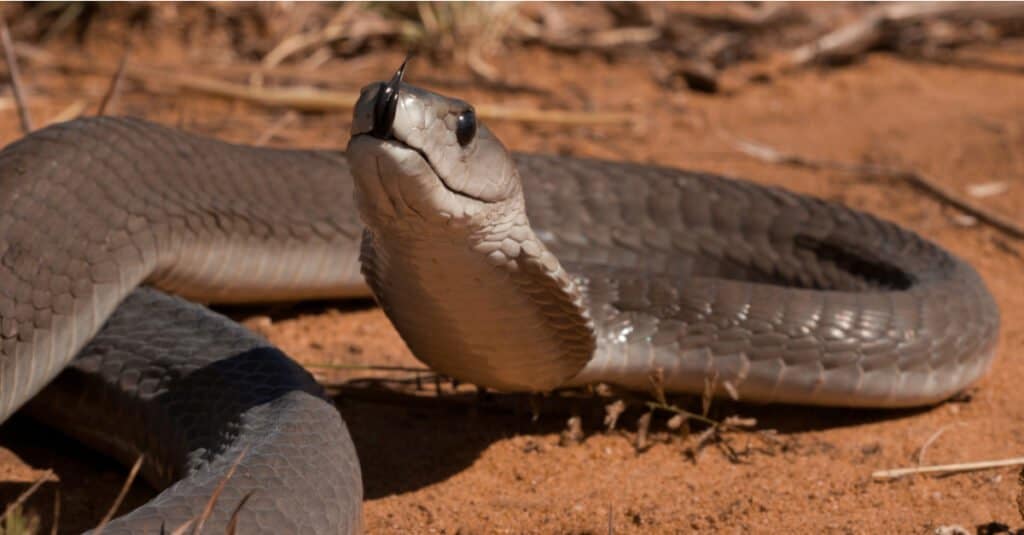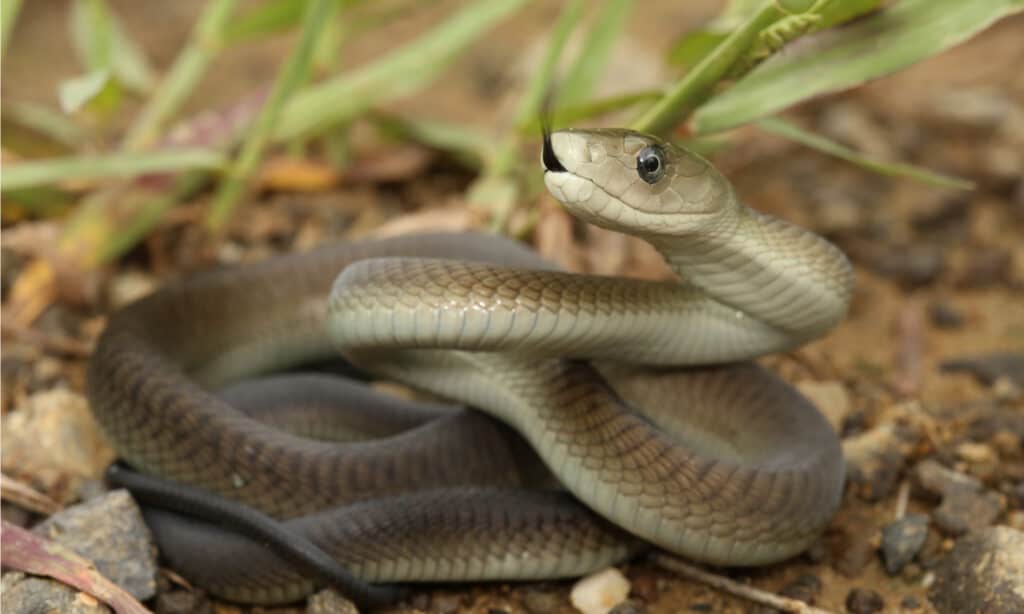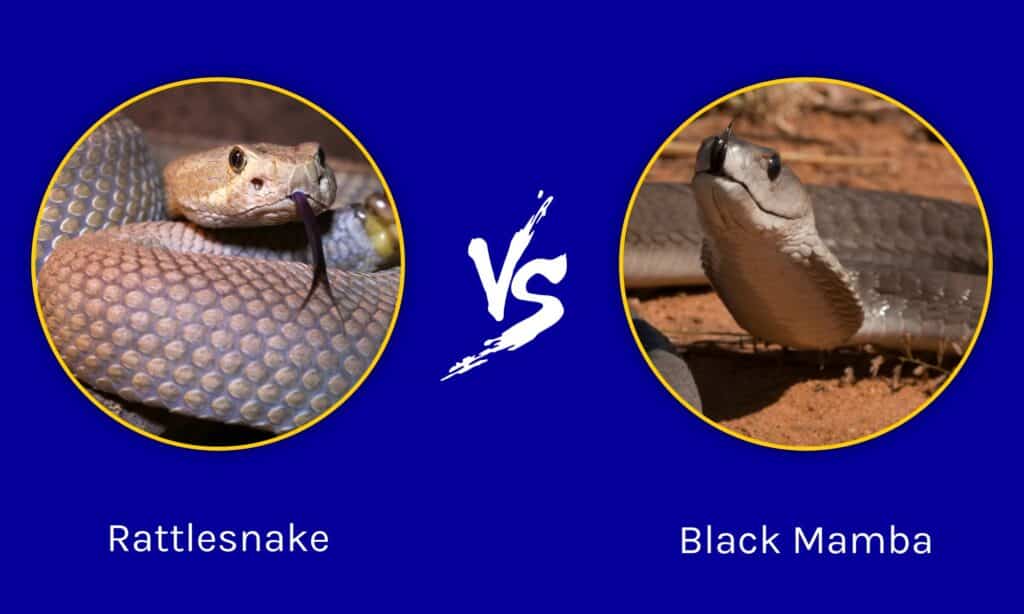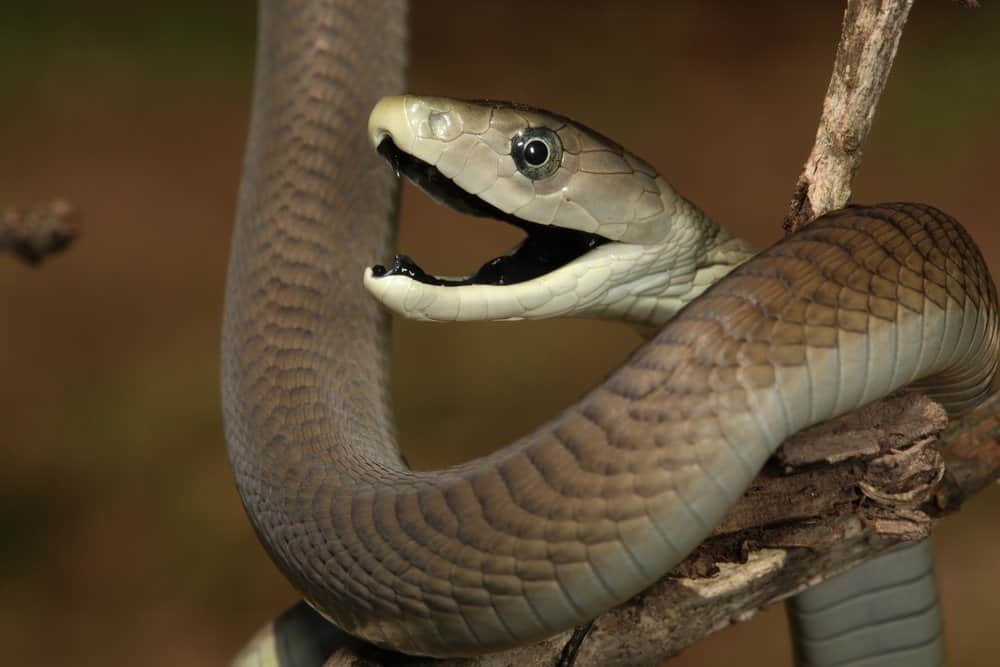The black mamba is an incredibly venomous snake native to sub-Saharan Africa. It belongs to the Elapidae family and is often more aggressive than other species of venomous snakes. This snake is amazingly fast and can often reach 12 mph in speed!
It is widely feared in Africa due to its venom and ability to strike several times at high speeds. Additionally, it is exceptionally long. So how big is the largest black mamba ever recorded?
Largest Black Mamba

The largest recorded of this species was over 14 feet!
©131346563/Shutterstock.com
The largest black mamba ever recorded was 14 feet, 9 inches in total. The king cobra is the world’s largest venomous snake; however, the black mamba is its closest rival in terms of size. When it comes to the length of this snake, its tail accounts for about two-thirds of its total length.
These snakes can grow to lengths of up to 9 feet in the wild, but the average adult’s length is a little over 6 feet.
Juvenile vs. Adult

The black mamba has the fastest trike of any snake.
©NickEvansKZN/Shutterstock.com
Juveniles are usually paler in color, almost grey to deep brown, depending on how old they are. It is possible for the younger snakes to have predators. However, once they are full-grown, they have very few natural predators.
The young tend to grow quickly, reaching over 6 feet just within their first year. When they reach adulthood, their nature becomes more unpredictable than when they were juveniles. An adult is skittish but also unpredictable with its movement.
It is incredibly fast but will not strike unless provoked.
About the Black Mamba

These snakes are both terrestrial and arboreal.
©iStock.com/Nicole_Marschall
Appearance and Behavior
Despite its name, black mambas are seldom black. While they are darker, the colors range from yellow-brown, light tan, olive, and gunmetal grey. Sometimes, their scales even reflect a purple hue. Their mouths are inky black and can often be on display whenever threatened. The black mamba, like the cobra, will lift its head and open its mouth.
It will then flick its tongue and even spread its neck into a hood before it lets out a series of hissing sounds. Usually, when it senses a threat is near, it will retreat into a hole or nearby brush, however, if its retreat is blocked, then it will begin its defense mechanism. If provoked, it will unleash a series of strikes, resulting in severe, often deadly consequences.
Where Do Black Mambas Live?
While this snake is native to sub-Saharan Africa, it can also be found in central Africa, South Africa, the Democratic Republic of the Congo, and Ethiopia. It prefers dry environments but also inhabits moist savanna and forests.
It is rated the least of concern on the endangered species list because of its distribution across sub-Saharan Africa. This snake has an exceptionally broad range of distribution, though its place in West Africa has been disputed.
What Do Black Mambas Eat?
The black mamba’s diet consists of birds and small mammals. This snake hunts from a permanent spot or lair and often retreats to it unless disturbed. It prefers warm-blooded prey and can also eat other snakes. It will usually eat small rodents, juvenile mammals, and bats.
During a hunt, it will strike its prey and let its venom run its course through the captive animal. The snake will wait for the animal to become paralyzed, and then it will swallow it whole, its potent digestive system fully digesting the prey for up to eight to 10 hours.
How Dangerous are Black Mambas?
The black mamba is one of the most venomous snakes on the planet. Its venom contains neurotoxins, often shutting down the nervous system and rarely causing any visible symptoms near the location of the bite itself. Symptoms of envenomation become apparent within 10 minutes and will require an antivenom.
If an anti-venom is not received, then a person will begin to experience respiratory failure, which will lead to cardiovascular collapse and then death. This usually will happen within a seven-to-15-hour time span. Because this snake is highly venomous, it is listed as a snake of medical importance by the World Health Organization.
How Do Black Mambas and Humans Interact?
These fierce snakes are feared and often killed by people because of their aggressive and dangerous reputation. However, it actually has a more nervous demeanor than an aggressive one. It is a skittish creature that doesn’t like it when humans approach too closely and will most likely try to hide or escape first. This snake only becomes aggressive when it feels threatened, often striking more than once very rapidly.
Black Mamba vs Rattlesnake: Who Would Win?

It is difficult to say for certain who would win in a fight between a black mamba and a rattlesnake as it would depend on many factors such as the specific species of rattlesnake, the size of the individuals involved, and the specific circumstances of the encounter. However, in general, a black mamba is considered to be more aggressive and venomous than most rattlesnake species.
Black mambas are known to be fast and agile, able to move at speeds of up to 12.5 miles per hour, and they have a highly toxic venom that can cause paralysis, breathing difficulties, and death within hours if left untreated. They are also considered to be more aggressive than other snake species, and they are not afraid to attack humans if they feel threatened.
Rattlesnakes, on the other hand, are generally slower and less agile than black mambas, but they do have a unique defense mechanism in their rattle, which they use to warn potential predators of their presence. Their venom is also highly toxic, but it typically takes longer for symptoms to appear and be lethal.
In a hypothetical fight between a black mamba and a rattlesnake, a black mamba may win, as it is considered to be more aggressive and venomous than most rattlesnake species.
In Conclusion

The black mamba is frightening due to its size and venom.
©NickEvansKZN/Shutterstock.com
In Africa, the black mamba is among the most frightening snakes because of its size, ferocity, and, most importantly, its venom. Before the 1970s, more people were likely to die when bitten by this dangerous snake. However, after 1962, an anti-venom was introduced, thus treating more patients bitten by this snake.
Usually, it is more common for humans to be bitten during their mating season. Bites outside of Africa are possible, though rare, mostly involving snake handlers. Though these snakes are fascinating to learn about, they should not be approached in any environment!
The photo featured at the top of this post is © iStock.com/Nicole_Marschall
Discover the "Monster" Snake 5X Bigger than an Anaconda
Every day A-Z Animals sends out some of the most incredible facts in the world from our free newsletter. Want to discover the 10 most beautiful snakes in the world, a "snake island" where you're never more than 3 feet from danger, or a "monster" snake 5X larger than an anaconda? Then sign up right now and you'll start receiving our daily newsletter absolutely free.
Thank you for reading! Have some feedback for us? Contact the AZ Animals editorial team.






